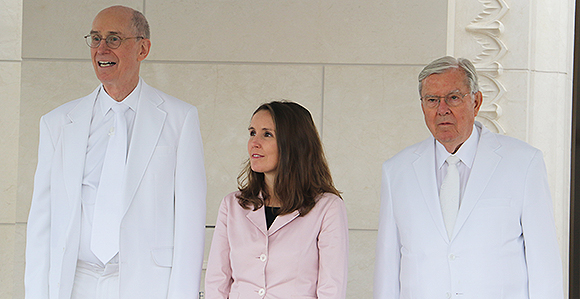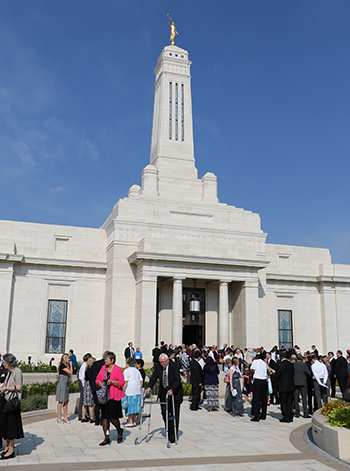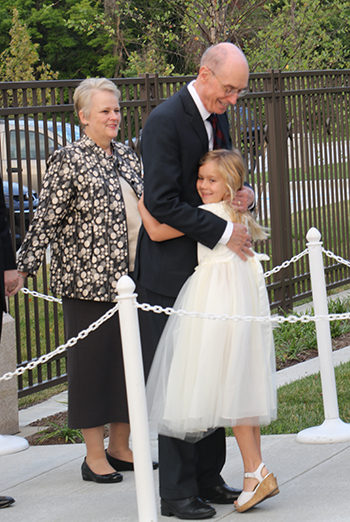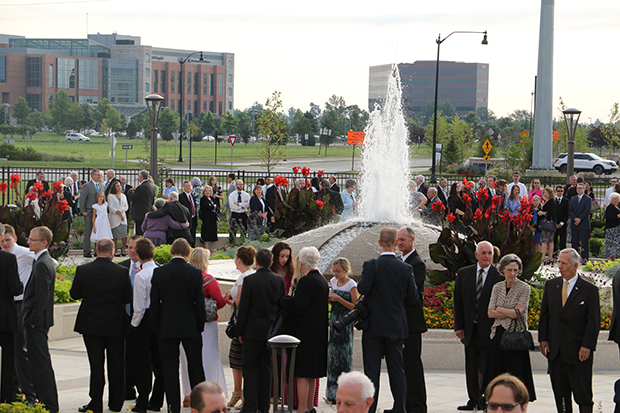President Eyring Dedicates Temple in “Crossroads of America”
Contributed By Sarah Jane Weaver, Church News associate editor

President Henry B. Eyring and his daughter, Elizabeth Peters, participate in the cornerstone ceremony with Elder M. Russell Ballard of the Quorum of the Twelve Apostles, right.
Related Links
INDIANAPOLIS, INDIANA
Because of the intersecting of important roads, railroads, and waterways in Indiana, the state has long been dubbed the “Crossroads of America.”
It is a motto that represents the central locale of the state not only as a transportation hub but also as a gathering place for people who come from different cultures, environments, and faiths, said Elder Paul H. Sinclair, who has lived in Indiana for the past 23 years.
“It is a crossroads not just on a map,” he said, paying tribute to the ethnic, religious, and cultural diversity in the state. People who come to Indiana bring experiences that strengthen the local traditions.
This makes the state—home to natives of 120 different countries—a “very rich place to live,” he explained.

Members of the Church gather on the grounds of the Indianapolis Indiana Temple on Sunday, August 23. President Henry B. Eyring dedicated the new temple. Photo by Sara Jane Weaver.

Elder Kent F. Richards and President Henry B. Eyring take part in the cornerstone ceremony of the Indianapolis Indiana Temple on Sunday morning, August 23, 2015. Photo by Sarah Jane Weaver.

President Henry B. Eyring is greeted by his granddaughter Evelyn Peters, 7, in front of the Indianapolis Indiana Temple on Sunday, August 23, 2015. Photo by Sarah Jane Weaver.
The Indianapolis Indiana Temple, which was dedicated in three sessions on August 23, will now become part of the rich fabric of Indiana.
“The temple will be one of those drawing places at the crossroads,” said Elder Sinclair, an Area Seventy and chairman of the local temple committee. “People will come [to the temple] from all over.”
President Henry B. Eyring, First Counselor in the First Presidency, dedicated the 34,000-square-foot temple, the 148th operating temple worldwide and the first in Indiana.
The temple, located in Carmel, Indiana, was announced by President Thomas S. Monson in the October 2010 general conference; construction began on the site in September of 2012. The temple will serve more than 30,000 Latter-day Saints from nine stakes.
Before dedicating the temple, President Eyring—who was accompanied to Indiana by Elder M. Russell Ballard of the Quorum of the Twelve Apostles and other General Authorities—greeted Church members gathered on the temple grounds and placed mortar on the temple’s cornerstone.
Elder Kent F. Richards of the Seventy and Executive Director of the Church’s Temple Department told the crowd that the cornerstone “is symbolic of Jesus Christ as the chief cornerstone of all that we do.”
Elder Sinclair said the local temple committee adopted Doctrine and Covenants 101:64 as a theme for the new temple: “That the work of the gathering together of my saints may continue, that I may build them up unto my name upon holy places.”
The temple—a blessing to those gathered in the Crossroads of America—is “truly about building Him and all those who come here in His name in this holy place,” he said.
Indiana has long been a gathering place for Latter-day Saints.
In 1831 missionaries arrived in Indiana and organized congregations. Joseph Smith even visited Greenville in 1832.
“By the middle 1840s, 30 counties in Indiana had active branches,” said President Koy Miskin, a member of the current temple presidency who served as historical cochair with his wife, Martha, on the temple committee.
However, by the late 1840s—when members moved west—there was not a trace of the Church in Indiana, he added.
The state did not have a notable Church presence again until 1927, when the first meetinghouse was constructed. Then, between 1940 and 1960, the membership of the Church in Indiana grew, as members began to settle permanently in the state. The first stake in Indiana, the Indianapolis Indiana Stake, was organized in 1959.
Brother and Sister Miskin moved to West Lafayette, Indiana, in 1978. At that time there was one ward in the city; four years later Brother Miskin was ordained the first stake president of the Lafayette Indiana Stake.
The Miskins learned that President Miskin’s ancestor joined the Church in Indiana in the 1930s before leaving the state. They now feel that by moving to the Hoosier State they were coming “home to Indiana.”

A choir of Latter-day Saints provides uplifting music for the cornerstone ceremony of the Indianapolis Indiana Temple as Church leaders prepare to seal the cornerstone.
Stephen Thompson and Ruthanne Thompson joined the Church in Indiana in 1965.
They moved to Utah to attend BYU and were planning to stay in the West when Brother Thompson received a priesthood blessing encouraging him to return to his home state.

Members of the Indianapolis Indiana Temple district perform during the temple cornerstone ceremony on Sunday, August 23, 2015.
Photo by Sarah Jane Weaver.
In 1967, when the Thompsons moved to Crawfordsville, Indiana, there was not a branch or missionaries in the area. They have witnessed the Church in Indiana grow in both numbers and respect from the community, said Brother Thompson.
“We have been extremely blessed to be a part of it,” said Sister Thompson.
Elder Sinclair said Brother Thompson is the only member of the committee who is a native of Indiana.
“The rest of us have been drawn here for one reason or another,” he explained.
The Indianapolis Temple will now draw others to the Crossroads of America, he said.

President Henry B. Eyring, first counselor in the First Presidency, and Elder M. Russell Ballard of the Quorum of the Twelve Apostles, and other General Authorities stand outside the Indianapolis Indiana Temple on August 23, 2015.
Larry and Gayle Shumard of the Fort Wayne Indiana Stake said Hoosier Latter-day Saints have been blessed in recent years to be surrounded by temples—in Columbus, Ohio; Louisville, Kentucky; Chicago, Illinois; Detroit, Michigan; and St. Louis, Missouri.
But traveling to those temples still required a good deal of sacrifice.
For the past three years, the Shumards have served as ordinance workers in Chicago—driving between three and four hours one way to the temple every other weekend.
Church members in Indiana now enjoy the blessing of a temple “because of the faith and sacrifice of generations,” Brother Shumard said.

President Henry B. Eyring and Elder M. Russell Ballard stand outside the Indianapolis Indiana Temple.
The architecture of the new temple pays tribute to Indiana and the people who, for generations, worked to build the Church in the Hoosier State.
The building is decorated with a motif of blossoms from the tulip poplar—Indiana’s state tree—and a motif of circles representing Indianapolis’s nickname, Circle City. The building’s architecture—and specifically its spire—echoes some of the historically significant buildings in downtown Indianapolis.
That symbolism makes it easy for locals to claim the temple as their own.
“It is an Indiana temple,” said Brayden Enz, 15, who attended the first dedicatory session. “It is not just any temple. It is ours.”

Members of the Church gather on the grounds of the Indianapolis Indiana Temple on Sunday, August 23. President Henry B. Eyring, First Counselor in the First Presidency, dedicated the new temple. Photo by Sarah Jane Weaver.

Evelyn, 7, Clarissa, 5, and Jane, 2—daughters of Joshua and Elizabeth Peters—wait for their grandfather, President Henry B. Eyring, to arrive at the Indianapolis Indiana Temple on Sunday, August 23, 2015. Photo by Sarah Jane Weaver.
Location: 11565 Temple Drive, Carmel, IN 46032
Plans Announced: October 2, 2010
Groundbreaking: September 29, 2012
Public Open House: July 17 through August 8, excluding Sundays
Cultural Celebration: Saturday, August 22, at the IUPUI Carroll Track & Soccer Stadium
Dedication: President Henry B. Eyring, first counselor in the First Presidency, dedicated the temple on Sunday, August 23, in three sessions
Property Size: 18.11 acres
Building Size: 34,000 square feet
Building Height: 106 feet, 4 inches
Tower: 96 feet, 10 inches, crowned with a 7-foot gilded angel Moroni statue
Exterior Features: The temple is built of structural steel and concrete with Aero Cream Limestone cladding quarried in Myra, Turkey, and fabricated in Isparta, Turkey.
Exterior Art Glass (also interior): The exterior art glass was designed by MHTN Architects of Salt Lake City, Utah, and was fabricated by Glass Images of Orem, Utah. Much of the glass came from Kokomo Opalescent Glass in Kokomo, Indiana.
Fountain: The fountain was designed by MHTN Architects and features two varieties of granite—Giallo Antico, a darker caramel color quarried in Brazil, and a lighter golden white color, called G350, quarried in northern China.
Interior Features Color Scheme: The primary color schemes are variations of blue with accents of gold and green. Interior wall color and coverings are similar to the warm tones of the limestone on the exterior of the temple.
Flooring: Floors and wall base throughout the temple feature Perlatino, Sahara Beige, and Artic Grey marble.
Millwork: Cherry wood from the eastern United States with a natural finish is featured throughout the building. The carvings feature a circle within a square, the Celtic knot, and the tulip poplar blossom.
Baptismal Oxen: The 12 bronze oxen supporting the baptismal font were sculpted and installed by Stan Watts, Atlas Casting of Kearns, Utah.
Mural: The original oil painting wall mural, depicting landscape scenes of Indiana, was done by Michael Albrechtsen of Olathe, Kansas.
The Indianapolis Indiana Temple is the 148th operating temple worldwide and the first in Indiana. The temple will serve approximately 30,000 Latter-day Saints in Indiana and eastern Illinois.
